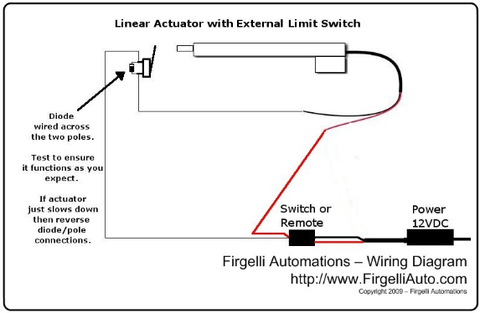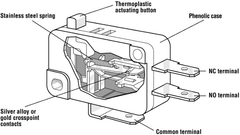How to Use an External Limit Switch with a Linear Actuator
An external limit switch is a very handy and cost effective means of controlling the travel of a linear actuator. In this article, we will go over how to use an external limit switch with a linear actuator.
Some electric linear actuators are made with built-in, programmable limit switches. This means you are able to adjust the travel of the stroke to your precise desired position. Of course this can be an extremely useful function, however it does require a bit more technical knowledge and this type of actuator can also be more costly.
Not all linear actuators are built with programmable limit switches. Instead, they will likely have built-in limit switches at the end of each stroke (extension and retraction). Some don’t even have limit switches at all. Both these types of linear actuators are very simple to use and generally more affordable. But you cannot control the travel distance.
So what do you do when the stroke is longer than you need?
Installing an external limit switch is the simplest and most affordable method to control the travel in electric linear actuators where the limit switch is either non-adjustable or non-existent.
There are three ways to control the stroke:
-
Limit extension
-
Limit retraction
-
Limit both extension and retraction
What is a Built-In Linear Actuator Limit Switch?
When you’re reading the specs for a linear actuator and it says “built in limit switch” or “non-adjustable limit switch”, this indicates that when the shaft extends and retracts, it will not only stop at the end of the stroke, but the motor will also shut off.
This is a very important feature because if it did not shut off the motor, it would continue to draw power which would very quickly burn it out.
What is an External Limit Switch?
External limit switches are used to make or break an electrical connection. It can be designed in many forms, but to put simply, it’s a device with a lever (or button or spring etc) that, once moved, will either close or open an electrical circuit. They are also designed in a variety of sizes and power to accommodate a wide range of motion control devices, from small electric linear actuators, to large high-power heavy-duty linear actuators.
The lever (or button or spring etc) must be moved by another force - in this example, a linear actuator. It can be pressed using several different ways. Common methods of activation include:
directly by the linear actuator
something attached to the linear actuator
touch-less using magnets attached to linear actuator and external limit switch
How to Use an External Limit Switch with a Linear Actuator
If you do not require the full stroke of your actuator you can use the external limit switch to cut power to the actuator once it reaches your desired travel distance.
External limit switches are easy to connect to your linear actuator and as previously discussed, provide a simple solution to stop the actuator from moving past a set position of your customization.
Parts
-
Firgelli External Limit Switch Kit for Actuators (EL-Kit)
-
Diode (comes pre-installed in Firgelli EL-Kit)
-
Fuses (optional
-
Control Source (switch or remote)
-
Electric Linear Actuator
-
Power Source
-
Wire Quick Connectors or Solder
Tools
-
Wire Stripper
-
Crimping Tool or Solder Iron
How to Wire it Together
Wiring the external limit switch to the linear actuator is extremely easy.
First connect power and control sources. Then, the external limit switch is connected to the ground cable only, between the control source (ex: rocker switch or remote control box) and the linear actuator. If need be, you can install fuses between the switch and the power source (fuses included in Firgelli EL-Kit).
Pay attention to the direction of the lever!
To add a second external limit switch, say to limit retraction, simply add it in the same way as the first, but reverse direction of the lever.
See wiring diagram below on how to use an external limit switch with a linear actuator.


